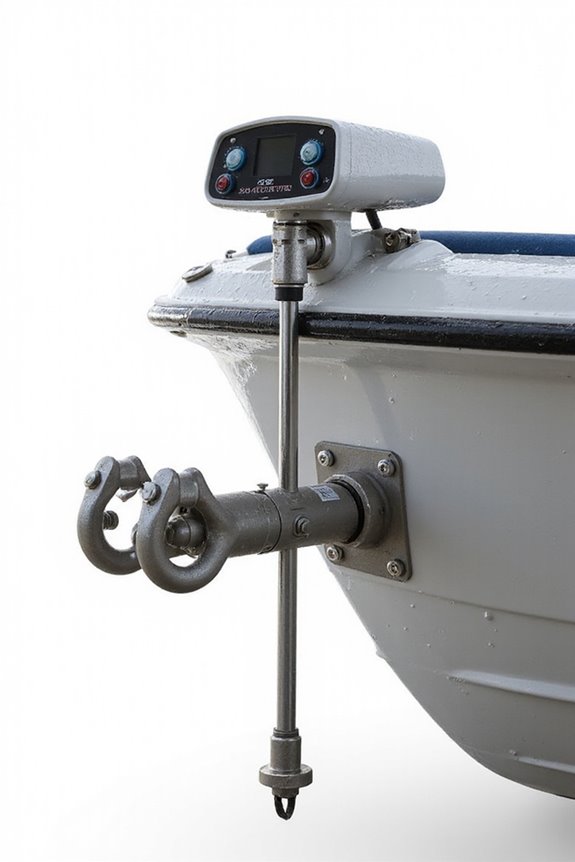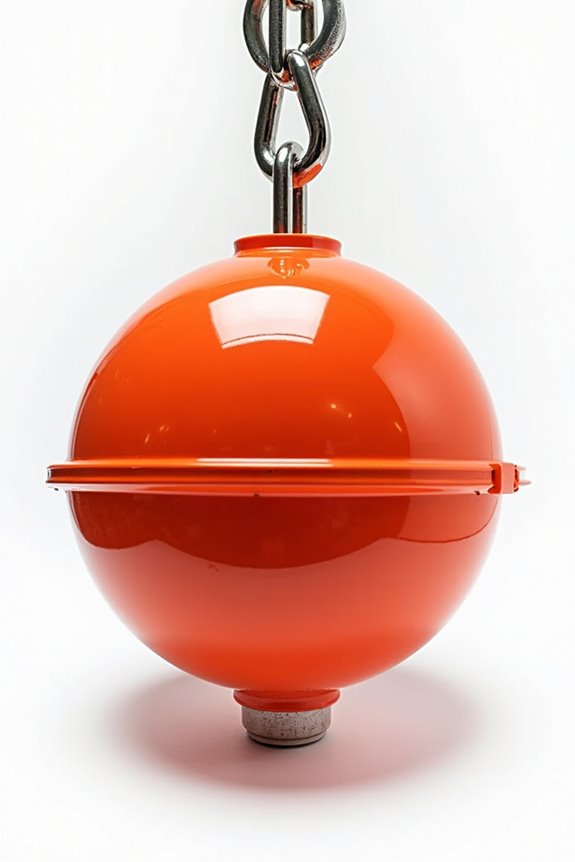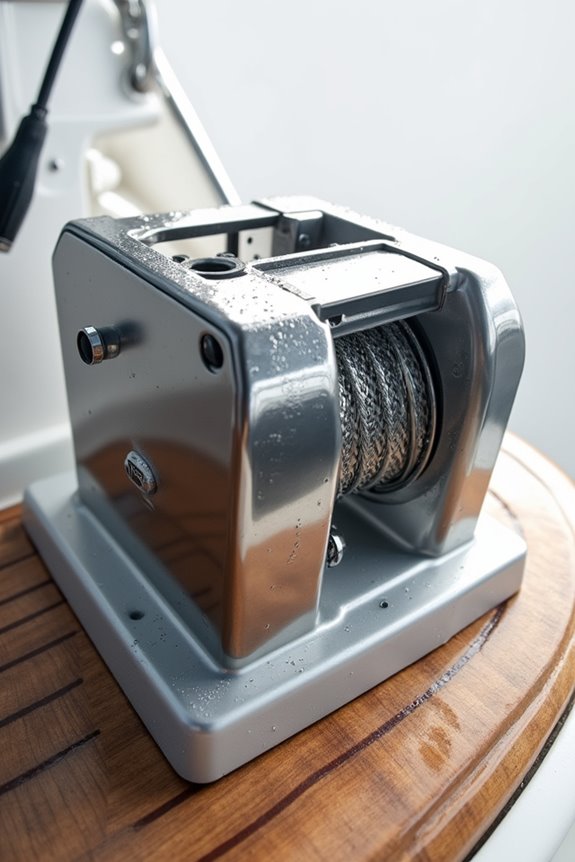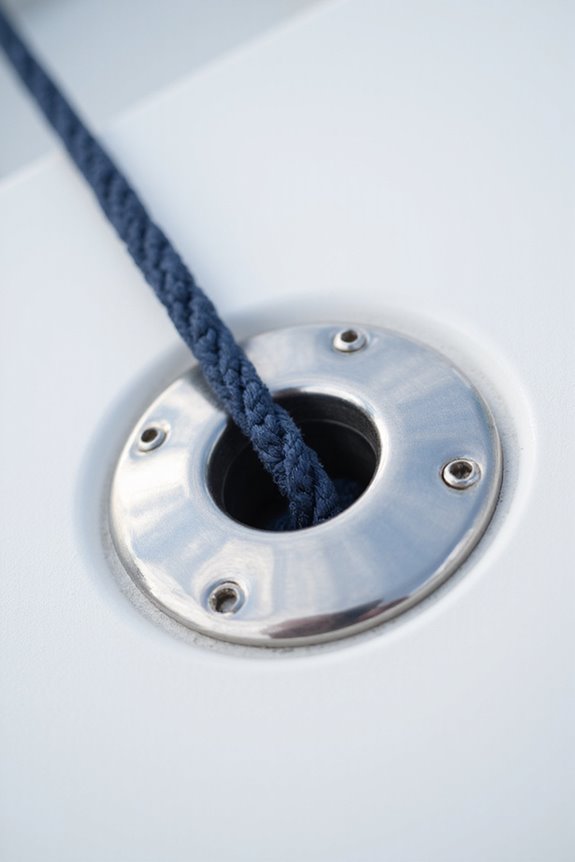So, shallow water anchors—ever try keeping your boat steady just a few feet deep? These clever systems use spikes or blades to grip soft mud or sand, perfect for boats under 26 feet. They’re easy to deploy manually or with motors, and they avoid wrecking the underwater scene. Plus, they help you fish or chill without drifting off. Of course, boat size, water type, and weather matter, but if you’re curious about installation and top brands, there’s plenty more to explore.
Key Takeaways
- Shallow water anchors stabilize boats up to 26 feet deep, ideal for depths up to eight feet without disturbing aquatic life.
- Various anchor types include telescoping spikes for mud, hydro-articulating arms, pole spikes, and blade anchors for different substrates and boat sizes.
- Deployment methods range from manual to electric or hydraulic systems, with multi-spike fiberglass designs enhancing grip and ease of use.
- Proper installation requires corrosion-resistant fasteners, marine sealant, and correct placement above the waterline for secure, water-tight anchoring.
- Regular maintenance includes inspecting rode and fasteners, rinsing saltwater, lubricating moving parts, and monitoring performance to ensure safety and reliability.
What Are Shallow Water Anchors?
Think of shallow water anchors as the unsung heroes for boaters who like to stay put in water no deeper than about eight feet. These clever devices use anchoring techniques tailored specifically for such shallow water, featuring an extension arm with a spike that quickly embeds into sandy, muddy, or clay bottoms. Ever struggled with your anchor dragging or noisy deployment? Shallow water anchors tackle this by driving their spikes silently and swiftly into the seabed, keeping your boat steady without disturbing fish or the environment. Mounted right on your boat’s hull or transom, they’re perfect for powerboats under 26 feet, especially when fishing or just relaxing. So if you’ve ever wanted hassle-free, precise positioning in shallow spots, these anchors might just be your new best friend.
How Do Deployment Mechanisms Work?
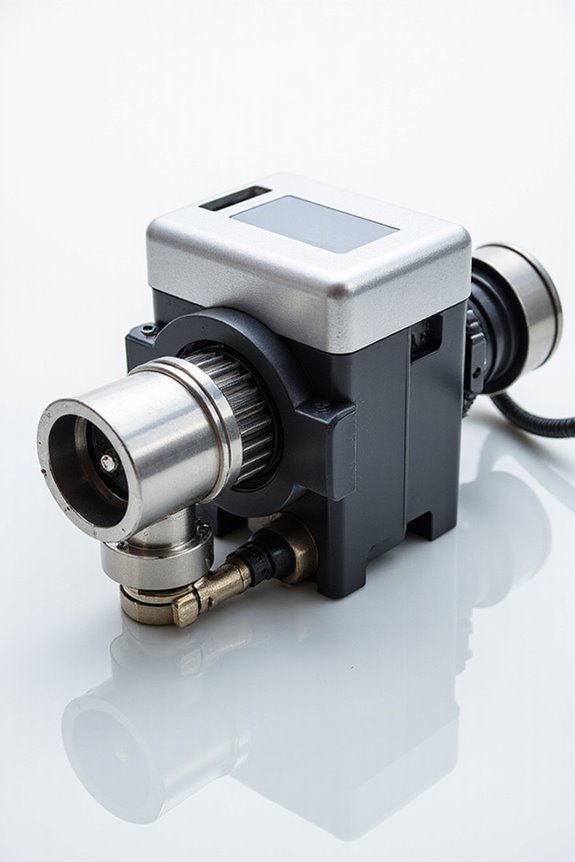
When it comes to deploying shallow water anchors, there’s actually a neat mix of technology and muscle behind how these systems work. We’ve got various deployment types—electric motors offer push-button ease, hydraulics provide silent, speedy action, and manual setups let us flex those arms with tensioning straps. But it’s not just about lowering the anchor; the engagement mechanisms matter too. Think spikes digging into the seabed or articulating arms spreading the load to keep your boat stable. Some designs even use multi-spike setups for extra grip, while others rely on fiberglass spikes for tough durability. Whether you’re using a remote control or adjusting the anchor depth by hand, knowing how these mechanisms interact helps us pick the right system and avoid becoming “that guy” drifting downriver!
Different Types of Shallow Water Anchors
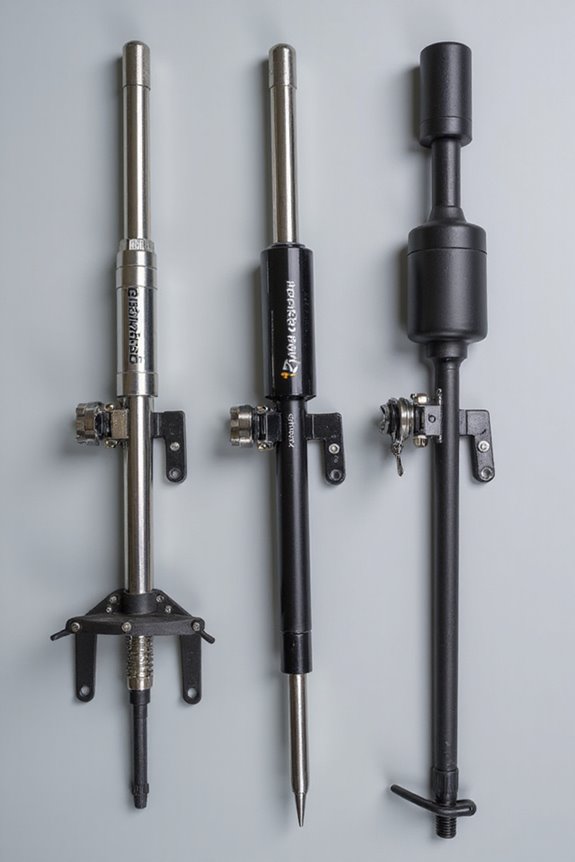
Before we plunge into specifics, it’s worth knowing that shallow water anchors come in several distinct types, each tailored for different boats and bottom conditions. We’ve got telescoping spike anchors that dive vertically into soft mud, perfect for a firm grip. Then, there are articulating hydraulic anchors, offering both downward and sideways hold but needing a bit more installation effort. If you’re after simplicity and quiet operation, pole spike anchors fit smaller boats just right—they’re straightforward and easy on the budget. Blade anchors bring strong holding power with smooth deployment, favored by many for their stability. When choosing anchor types and deployment strategies, it boils down to your boat size, water bottom, and how fast or quiet you want to drop anchor. Sounds like a plan, right?
Typical Installation and Mounting Options
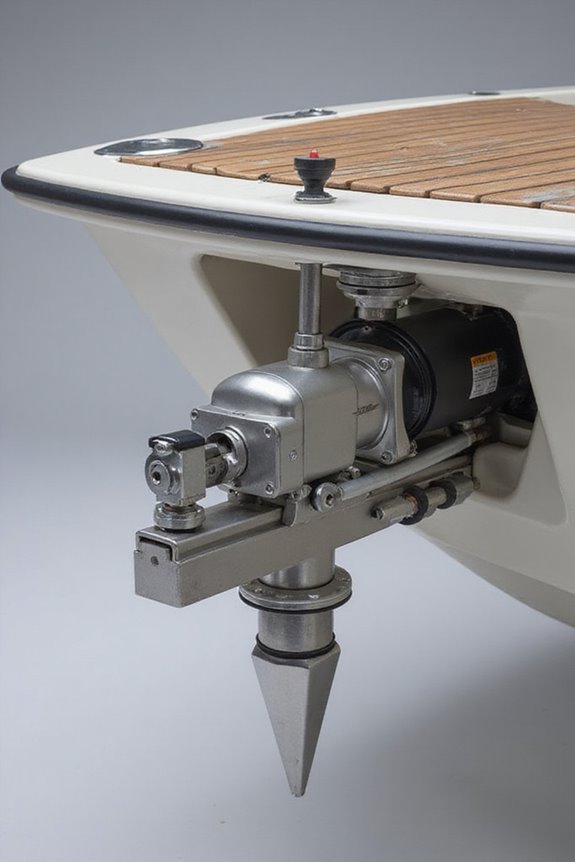
There are a handful of key steps we’ve got to cover when installing a shallow water anchor—each one important to make sure your setup works smoothly and lasts through waves, wind, and occasional surprises from curious fish. First, choosing the right mounting locations is essential—pick a transom spot well above the waterline, away from trim tabs or motors, that’s easy to access for wiring and maintenance. Next come drilling techniques: use a template for precise hole placement, then drill carefully with the right bits—don’t forget marine sealant to keep everything water-tight. Once mounted with corrosion-resistant fasteners, we wire up the electronics close to a power source, sealing all connections to keep moisture out. Got all that? Your anchor’s nearly ready to handle whatever shallow waters throw at you!
Benefits Compared to Traditional Anchors
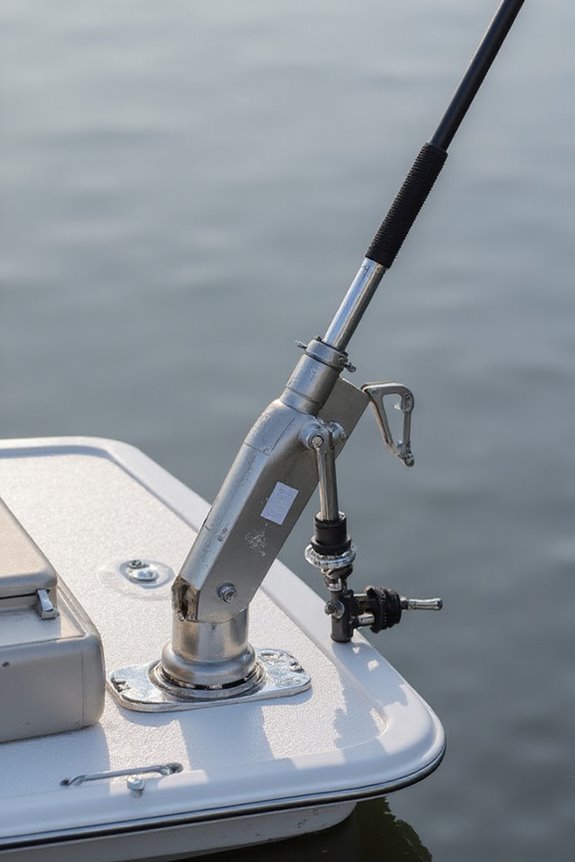
Now that we’ve covered how to install and mount your shallow water anchor properly, let’s chat about why these anchors often outshine traditional ones. First, their anchor efficiency is impressive—they dig directly into the sediment or slip into rocky crevices, offering superior holding power especially in shallow, tricky spots where old-school anchors might flop around. Plus, they save us the hassle of guesswork and heavy lifting, making anchoring quicker and less stressful. But it’s not just about convenience; these anchors bring ecological benefits too. By disturbing less sediment and avoiding damage to fragile aquatic plants or reefs, they help preserve the underwater environment we all enjoy. So, aren’t these anchors a smart choice for boaters who care about both stability and the planet? We think so!
Optimal Conditions for Using Shallow Water Anchors
Since shallow water anchors are designed with specific environments in mind, choosing the right spot can make all the difference for your next outing. Our ideal environments? Lakes, marshy coastal flats, shallow bays, even ponds and rivers where deeper anchors just won’t cut it. When we talk anchoring techniques, it’s important to take into account water depth and bottom type—mud or sand often works best for holding power. Ever tried anchoring in thick aquatic vegetation? It’s tricky, but some systems handle this better than others. These anchors excel in keeping us stable against winds and currents, perfect for fishing or just relaxing. So, next time you plan a trip, remember: location and technique go hand in hand to make sure we stay put and enjoy every moment. Who doesn’t love a spot that holds steady?
Limitations and Considerations for Use
We’ve covered where shallow water anchors really shine, but let’s keep it real—these anchors aren’t perfect for every situation. Their anchor effectiveness depends a lot on depth, bottom type, and model; they’re great in soft, shallow spots but struggle in rocky or super deep waters. Plus, while they’re fantastic for precise positioning, they might not hold up in rough, long-term conditions. Another thing we can’t ignore is environmental considerations. These anchors cause less sediment disturbance than traditional ones, which is a win for aquatic habitats, but careless use can still harm sensitive areas. So, it’s smart for us to stay aware of local rules, monitor our anchors carefully, and remember that sometimes, the right choice boils down to knowing when to use them—and when not to.
Popular Brands and Their Features
Choosing the right shallow water anchoring system can feel like picking a favorite fishing lure—there’s a lot of options, and each one has its own perks that appeal to different styles and needs. Take Minn Kota’s Talon features, for example—their 3-stage vertical deploy spike gives precise anchoring with thoughtful flexibility for various mounts. On the other hand, Power Pole innovations take hydraulics seriously, with their ONE Pump powering faster, quieter deployments and their nearly indestructible Everflex® spike. Both brands offer customization and reliable performance, though Talons are praised for durability while Power Poles shine in smoothness and stellar customer service. So, are you more about brute strength or silky smooth control? Whichever camp you’re in, these top brands make sure your boat stays put, letting us anglers enjoy our time on the water instead of wrestling with anchors.
Tips for Maintaining and Operating Your Anchor System
Although anchoring systems might seem low-maintenance, keeping them in tip-top shape means fewer surprises when we’re out on the water—and nobody wants their anchor staging a surprise party at the worst time. Regular maintenance tips, like inspecting the anchor rode for wear and rinsing it with freshwater after each trip, are essential. Don’t forget to check shackles and chains for corrosion or damage; replacing these components before they fail keeps us safe and secure. We should lubricate moving parts and tighten all fasteners after about 100 cycles to keep everything running smoothly. Also, stowing the Power-Pole properly and managing the anchor rode’s pyramid shape in the locker prevents jams. Are these checks a hassle? Maybe a bit, but isn’t peace of mind worth it?
Frequently Asked Questions
Can Shallow Water Anchors Be Used in Saltwater Environments Without Corrosion?
Isn’t it a coincidence that shallow water anchors made from fiberglass offer exceptional corrosion resistance? Together, we’ve found that following simple maintenance tips guarantees they stay reliable and long-lasting in saltwater, helping us all enjoy worry-free boating adventures.
How Do Shallow Water Anchors Affect Boat Battery Life Over Extended Use?
It is understood that shallow water anchors increase power consumption, which stresses batteries over time. By practicing smart battery management—like avoiding deep discharges and using proper chargers—we can extend battery life and keep our boating community thriving.
Are Shallow Water Anchors Compatible With All Types of Boat Transom Materials?
Like fitting puzzle pieces, transom compatibility isn’t one-size-fits-all. It is understood anchor installation varies by material—fiberglass, aluminum, wood—so picking the right mount keeps our boating community secure and connected on the water.
What Safety Precautions Should Be Taken During Anchor Deployment and Retraction?
When it comes to anchor safety, we always follow careful deployment procedures: approaching slowly, lowering the anchor gently, and using proper equipment during retraction. Together, we guarantee smooth, secure anchoring while watching for hazards and controlling speed.
How Do Weather Conditions Like Wind and Current Influence Shallow Water Anchor Holding?
It is understood that wind resistance and current stability greatly impact our anchor’s hold. In strong winds or currents, we rely on deeper penetration and multiple anchor points to keep us secure, ensuring we stay safely grounded together.

